
|
||
|
Portland art blog + news + exhibition reviews + galleries + contemporary northwest art
|
||
Interview with Inigo Manglano-Ovalle Part I Inigo Manglano-Ovalle was born in Madrid, Spain in 1961, lives and works in Chicago, Illinois. He was educated at Williams College and The School of the Art Institute of Chicago and he has exhibited his works widely since his first solo exhibition in 1991. Ovalle teaches at the University of Illinois, and has been a MacArthur fellow since 2001.
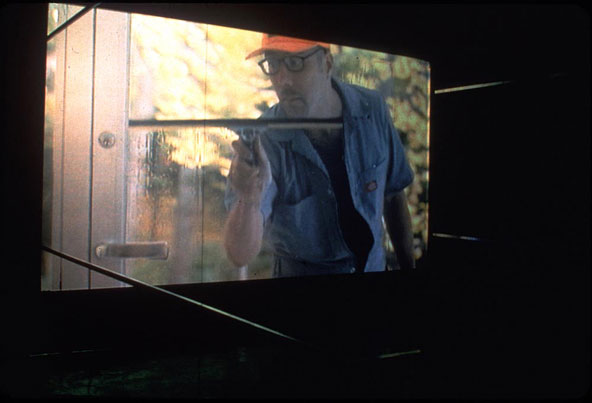 Le Baiser - The Kiss (1999) Ovalle (pictured) Each of Manglano-Ovalle's works exists as an independent experience that develops personal and abstract social narratives. Every story can be seen on sight or developed by researching the references Ovalle is using or by bringing in outside associations. In Le Baiser - The Kiss (1999) Ovalle provides a multi-channel projected video and mixed media installation with audio recording. The video depicts a window washer opposite a woman listening to music in Mies van der Rohe's Farnsworth House. There is an unresolved tension and a strong sense of voyeurism. 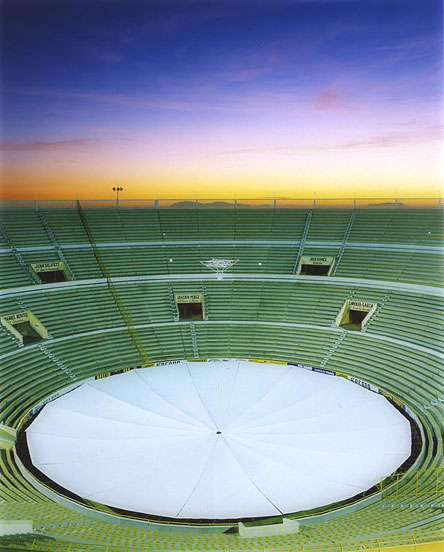 Search - En Busquedad (2001) Recently in Portland's Broadcast show at the Lewis and Clark Hoffman Gallery he displayed Search - En Busquedad (2001) composed of a color photograph laminated to plexiglass 58 x 48 inches with flanking speakers replaying some of the audio that the Radio telescope installation at the Plaza Monumental Bullfight Ring in Tijuana, Mexico captured. A joking commentary on illegal immigration. 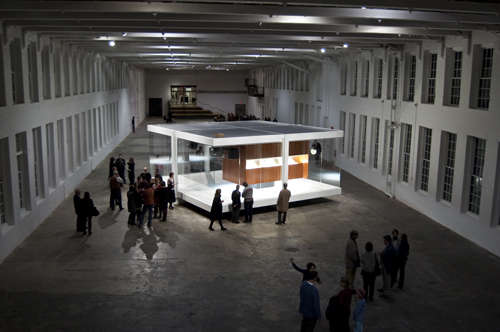 Gravity Is a Force to be Reckoned With at Mass MOCA (photo Dylan Lathrop) Currently showing at Mass MoCA is Manglano-Ovalle's Gravity Is a Force to be Reckoned With a 25 x 25 recreation of Mies' famous unbuilt glass house. In conjunction with the installation his video Always After (The Glass House) is being screened. It's a depiction of broken glass being swept in a 9 minute 41 second continuous loop projected onto a large wall. It adds a tension to the upside down 25x25 house with four pillars as you walk to the back of the warehouse.  Schematic of Gravity Is a Force to be Reckoned With (2009) Gravity Is a Force to be Reckoned With itself is is a half size realization of Mies' House with Four Pillars upside down – with the exception of a single coffee cup that has fallen to the ground, broken and spilled its contents. On the coffee table is an Iphone that plays 30 short videos over the course of an hour and a half. On the reverse side of the house is lounge chair is a copy of Yevgeny Zamyatin's We which is the second element that composes the project. The third being Sergei Eisenstein’s Glass House an unfinished movie based on We. And when you go past the video Always After (The Glass House) there is a hall that take you up stairs to the mezzanine on the far wall there is a single drawing for The House with Four Pillars with the quote from We, "Well, now, fallen angle. You, I'd say, are now lost." The Max Protetch Gallery is currently hosting Happiness Is a State of Inertia. The show is comprised of a lighted fish tank in the shape of Meis' House with Four Pillars. Dwelling inside the structure are blind Mexican cave fish. On the walls of the gallery are four way mirrored satellite images of a fraction of the ice caps over a period of time. And in the back room are drawings of The House with Four Pillars. The juxtaposition of elements allows the viewer to open-endedly narrate the relationships between Heideggerian notions of dwelling on macro and micro levels. Recently I took a trip to the East Coast to see Manglano-Ovalle's two shows Gravity is a Force to be Reckoned with (Mass MOCA) and Happiness is a State of Inertia (Max Protetch Gallery). This is the conversation we had about his work in the Max Protetch Gallery on February 5th before the opening. (Alex)There is a cardboard box on top of Gravity is a Force to be Reckoned with, what is it referring to? (Inigo) I was interested in this mirror. In particular about this piece I was talking with this engineer - Bill Baker is one of the partners of SOM (Skidmore Owings Merrill) who was a protégé of Mies' engineer. About five years ago we had a plan to build this. He's a structural engineer - he's not an architect - but an engineer. He does the engineering for all these buildings plus other buildings around the world for other firms. And he had happened to study under this other engineer Myron Goldsmith who was Mies' engineer. For a lot of his projects… he did the national gallery, Bacardi (office building), Farnsworth and so forth. So when Mies developed his theoretical project the house with four columns - some people call it the 50 x 50 to shorten it. I think it's a little pedantic to call it the 50 x 50. I like the idea of The House with Four Columns. Because the emphasis is that the columns are not in the corners they are on the sides. So you have these cantilevering corners and this is the problem; engineering that expanse with those corners to cantilever. Alright? To stay up… that was Myron Goldsmith and this engineers' problem to solve with that house. Does the box emphasize the flexing or stuctural forces at work? The easiest way to talk about the box is that basically what we are building is "a box." The house is a box. 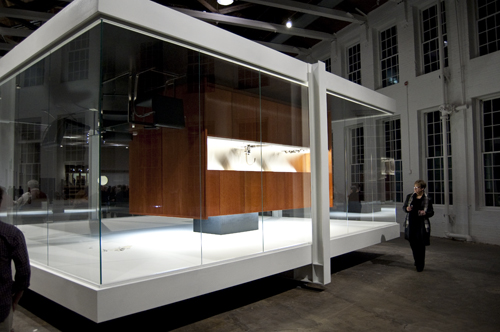
Gravity Is a Force to be Reckoned With (2009) at Mass MOCA (photo Dylan Lathrop) The house is a box? It's a box. On one level it's a box. And when you start listening to a lot of the messages that are left these is a kind of meta-critique in them. It's not just about (the book) We. It might also be about the artist. It might be about what you're looking at. So the box might be the building but the box is also something that they talk about. (in We) One woman says that, you don't seal the top. Make sure it isn't conspicuous. You have a tendency too… I forget the quote. She's telling him he shouldn't be noticed. But that's what she loves about him that no-one notices him. Then his friend the poet/philosopher mentions that I've seen you with the box. And other people have seen you with the box. So what is the box? I don't know what exactly the box could be. It could be a present, or it could be some kind of delivery, of some sort of device, it could be explosives, it could be "the unidentified object left behind." You know… which in a sense for me it is. It's a kind of reference to a package that is left somewhere that empties out a building. Package that… Oh. Yes. And the box that we have up there, (on top of Gravity is a Force to be Reckoned With) right, and you never see this box unless you go up balcony and then you realize on the roof (actually the floor) of the house is a box. And everybody thinks that the artist just left something up there. And it's located in such a way that everybody thinks we forgot a box up there. And that is how you want it to be read - in a way. That's funny because there were some people I was explaining the piece to and they went up to the balcony and when they asked about the box. I didn't know. I asked the security guards who worked at MASS MoCA. They told me a lot of other things about the piece but didn't know about the box. Yeah at one point the box was going to be in that huge hall somewhere… just somewhere. And I didn't like it because it compressed - called too much attention. I like this more. Yeah, there is that grand space walking up to it in the fantastic lighting. And that box I mean in Myron's sake, right? That box is actually a model of the building. Because it's a store shelf box but it's the exact proportions of the building we just built. And then when you fold over the top. The way he (D-503) was instructed not to tape the top he's probably already taped it so if you look at the box it's probably been taped, opened and folded again. And when you do that the top section of the box is sitting there folded. The top folded looks just like the roof section of the piece which, as you know has the metal ribs going this way in two quadrants.  Detail od Sol LeWitt at Mass MOCA Which is me giving a little homage to Sol LeWitt. It is me playing the fan of Sol LeWitt. An homage to Sol LeWitt? LeWitt is there (Mass MOCA) in a big way But you know what's interesting too - that (Mass MOCA) piece and this (Max Protech Gallery) piece too. That literally sometimes people think that what I'm doing is just riffing on Mies. And in many ways I'm not. I'm just using him as a stage. In many ways I'm for example riffing on other artists. So the bit multiplies - a number of them. One of the things that building is referring to and this piece (the fish tank) here refers to is LeWitt's open ended cubes. His unfinished project of these open ended white cubes, right? So with the drawing at MASS MoCA I notice the reference to the character I-330. Is there any reference to Duchamp's Bride in that? Because it seems that the house becomes a woman. It is seductive and cold much like the woman in Farnsworth house and the Farnsworth House in your video The Kiss. 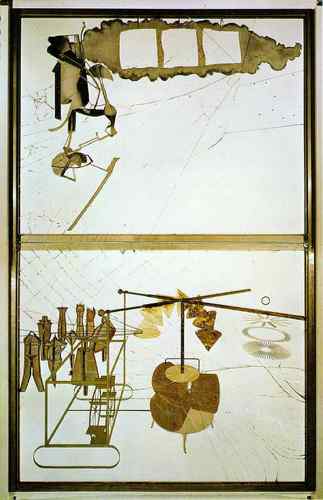 Duchamp's Large Glass There is in that. I think that what We allowed me to do in the Farnsworth House for The Kiss played out, is this relationship between this man and this woman. And there the relationship is one that is historical. In that since - here is this female figure that occupies the house, she is introverted and into music, and here is the window washer who is basically taking care of the form: the surface. He's the kind of the architects who is own obsessed with the form. She (resides in the building) is more of a kind of introverted. He's looking at the shape - the outside, the external. And she is inside and dealing with what's internal. What happens in the Farnsworth house is that she is the only one that actually looks into the camera back at you. SO, she this introverted person acknowledges, looks straight out at the viewer, at a close up at some point - whereas the window washer never acknowledges the viewer. In other words he is always being viewed at - but by us not by her, which is a kind of complexity. But there the issue was: I don't know if I am historically referring to Farnsworth or Mies. There is this problematic relationship; this close but worlds apart or am I just basically talking about the patron and the artist… or the home owner and the pool boy… or the plumber? How big of a role does glass as a literal and/or metaphorical narrative occupy in the work? It seems very apparent that it plays a huge role within your recent work. I think that to me that there is this notion of being interested in transparency. So I use that type of architecture as a stage - this emphasis on the whole weight and the notion of the marvelous glass house. Or even how high modernists use transparency; Dan Graham's glass cubes… Larry bell's plastic… where transparency is this kind of formal issue. And I am really interested in politicizing transparency. In other words asking if things are actually transparent… when things are transparent. Especially when they ARE transparent - are they really transparent? So when things are offered up as transparent in a name or sense. You see the transparence to deflect the fact that they are more opaque than they should be on a political level. Makes me think of the 911 report - there is a huge book that is suppose to make it transparent. Does the copious amount of information make it transparent? It makes me think of the blind fish in the fish tank with four pillars.  Foreground Bauen, (2010) aluminum, glass, water and Astyanax fasciatus mexicanus (Blind Mexican Cave Fish) 27 1/2 x 54 1/2 x 54 1/2 inches, courtesy Max Protetch Gallery Yeah there are in that piece the riff on the building and how the building may convert itself into… because the fish's natural habitat is a cave. How then is the building actually a chamber? And it's a low chamber - subterranean chamber. They're blind so then the notion that they're blind calls into question transparency and visibility too. Where is knowledge? Do we get knowledge through vision? Is actually seeing a channel of knowledge? So they then piece in the sense by virtue of having this specific species in there make it a dwelling, right? Into a cave, right? What I'm interested in there is that one of the reading that I'm inquiring is going back to Plato's cave. To this notion of knowledge being born of out of seeing one's shadows being cast on the wall for the first time, right? And seeing ones own form on the wall and not recognize that it is you who you are seeing. In Plato's cave he's imagining early man for the first time "caveman" seeing the light of the world coming into the cave and one of the first things he is able to see is the actual shadow on the wall. But he's separate from it because he has no experience of what generates that, right? And so this is the beginning of a kind of knowledge, trying to make the connection towards essentially something that might be connected. Seems interesting, a sincere narrative via very stark irony. Um huh in all of them How would you describe your use of paradox as a narrative? How would you reformat that because that is a heavy question "paradox as narrative?" It seems like your pieces always have inherent paradoxes - for example, the fish are blind and while talking you have a sincere narrative about these political commentaries about transparency, while relating it all formally to glass. The paradox becomes this narrative and a lot of times it's hard to understand as the "viewer." But as a story teller "you" are much clearer and less of a paradox while the visual piece is a paradox for the viewer to narrate though. It's essential for me for the viewer… One of my tactics in terms of how I am interested in operating as politics in and of its self - is that my work doesn't didactically make a political statement. But it induces a moment, right? In which the viewer now has to come to grips with a particular judgment that they have to make. A particular type of interpretation they have to make, an experience with the piece. So then the realization of paradox is located in the viewer not in the work - in the experienced. For example, when I was very young at the Prado in Spain I went to see or I happened across… probably for the first time, Goya's dark paintings - a picture of Saturn devouring his child. And I was intrigued with how beautiful all these painting were. They were just gorgeous. But they depicted something so monstrous. So there is this situation that occurred to me that I've always been interested in since then is that one might see a work and say "oh how beautiful, oh how monstrous" The dilemma there is that you now have to think about the aesthetic and ethics, right? That you have to arrive at the point and say that a monstrous thing is beautiful. And the criteria is then that you are implicated in the irony of the situation or paradox of the situation. Do you know what I mean? 
Yeah! It exactly relates to the four pillar house. I was reading People Who Live in Glass Houses By Charles Giuliano when you were talking to the curator of MASS MoCA. Where Giuliano wrote about the paradox between the angst of being trapped in the glass house but extremely attracted to it. There is an attraction vs. utility paradox, right? And it relates to a lot of things like women. Then I relate it to the house for me which turns the house into a woman. I'm really interested that you read that that why. Because the occupant of the house for me is the protagonist of We who never answers the phone. So the house the owner is the absent protagonist. For me. It's this male guy. But since the piece itself, the whole piece "Gravity is a Force to be Reckoned With" I would say and agree with you is actually driven by a woman, right? Who criticizes, who seduces, who cares… who you know… so the piece itself has a feminine protagonist. Even though the actual - if we were to write the screen play for the story the person who lives in the house is a guy. He's D-503 or me. Or anybody Right Exactly. It is left open like that. With all the references it is hard when learning about the piece and it seems like a very student/teacher experience. It is great for me to go out and learn these new elements and I hope that other people are driven to learn about the piece more than just on a visual level too. Because now you are referencing the box while echoing the box and that is a clear and self evident visual statement. Still, there is so much meta-narrative that goes along with it. An interesting thing is that it all spawns from the creator. That is why I find it very interesting, because it seems that the house could be "woman." Like a Duchampian ideal with the notions of the bride and the machine. Then I place you in the house because you are the creator. Continued in Part II Posted by Alex Rauch on February 27, 2010 at 17:44 | Comments (0) Comments Post a comment Thanks for signing in, . Now you can comment. (sign out)
(If you haven't left a comment here before, you may need to be approved by
the site owner before your comment will appear. Until then, it won't appear
on the entry. Thanks for waiting.)
|
| s p o n s o r s |
 |
 |
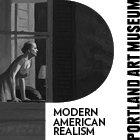 |
 |
 |
 |
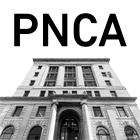 |
 |
 |
 |
 |
 |
 |
 |
 |
 |

|
Site Design: Jennifer Armbrust | • | Site Development: Philippe Blanc & Katherine Bovee | |

